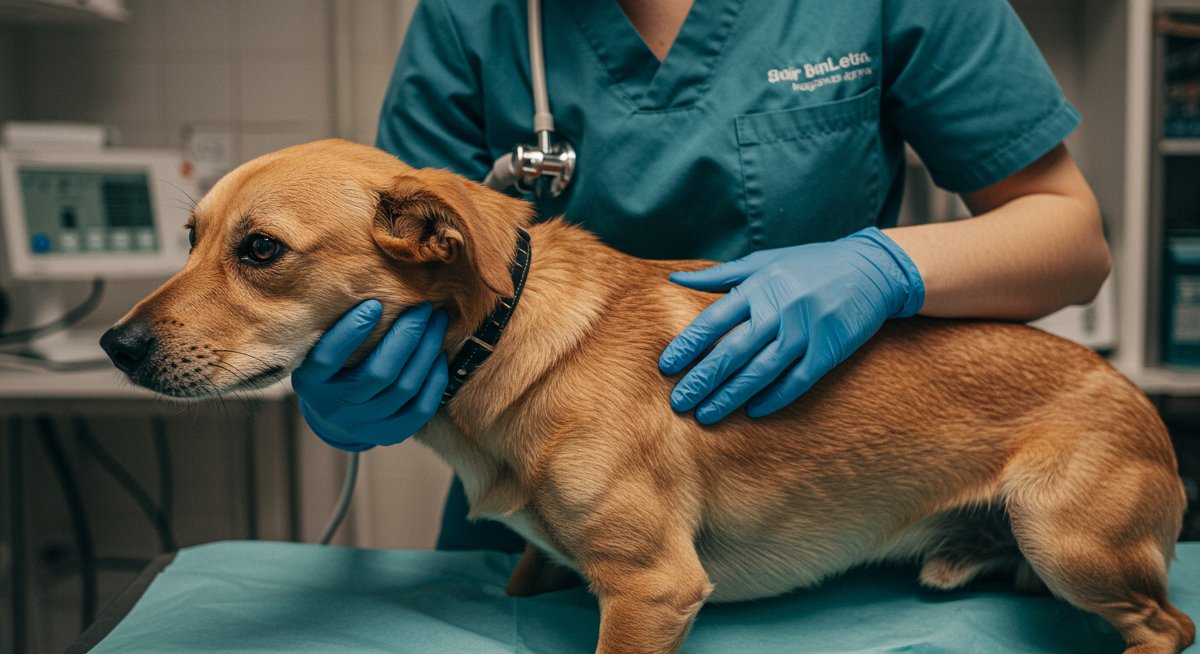
Is your dog constantly scratching, chewing, or licking their skin? Skin allergies are a common problem for dogs. Understanding the causes, recognising the symptoms, and knowing how to provide relief are crucial for ensuring your dog's comfort and well-being. This guide will walk you through dog skin allergies, providing advice and solutions to help your furry friend find relief. We'll explore the different types of allergies, from environmental factors to food sensitivities and flea allergies, giving you the knowledge to take proactive steps in managing your dog's health.
Why understanding dog skin allergies is crucial
Dog skin allergies, also known as canine allergic dermatitis, can affect your dog's quality of life. The constant itching, scratching, and discomfort can lead to secondary infections, sleep disturbances, and behavioural changes. Untreated allergies can worsen, making them harder to manage. By understanding the causes and symptoms, you can provide timely help and prevent these issues from escalating. Early detection and treatment alleviate your dog's suffering and contribute to their long-term health and happiness. Ignoring the signs of allergies can lead to chronic skin conditions, decreased immune function, and a diminished bond between you and your pet.
Essential first steps for managing dog skin allergies
Recognising the symptoms
The first step in managing dog skin allergies is recognising the signs. These can vary depending on the type of allergy and the individual dog, but some common symptoms include:
- Excessive scratching: This is often the most obvious sign. Dogs may scratch at their ears, paws, belly, or other areas of their body.
- Licking or chewing: Dogs may lick or chew at their paws, legs, or other areas to relieve itching.
- Redness and inflammation: The skin may appear red, inflamed, and irritated.
- Skin lesions: Sores, scabs, or crusts may develop due to scratching and self-trauma.
- Hair loss: Constant scratching and licking can lead to hair loss in affected areas.
- Ear infections: Allergies can make dogs more prone to ear infections.
- Recurring skin infections: Bacterial or yeast infections can occur as a result of damaged skin.
Example 1: Max, a Labrador Retriever, started excessively scratching his ears and licking his paws. His owner initially dismissed it as a minor irritation, but the symptoms worsened. Upon closer inspection, they noticed redness, hair loss, and scabbing. This prompted a visit to the vet, who diagnosed environmental allergies.
Example 2: Lily, a small Poodle, developed a rash and began scratching her belly relentlessly after a change in her diet. Her owner initially suspected the new food. After ruling out other causes, a food allergy was confirmed through an elimination diet.
Identifying potential allergens
Once you've recognised the symptoms, the next step is to identify potential allergens. There are three main types of allergies in dogs:
- Environmental allergies: These are often seasonal and can be triggered by pollen, dust mites, mould spores, and other environmental irritants.
- Food allergies: These are caused by specific ingredients in your dog's food, such as beef, chicken, dairy, or wheat.
- Flea allergies: These are caused by an allergic reaction to flea saliva. Even a few flea bites can cause intense itching and skin irritation.
Seeking veterinary advice
It's essential to consult your veterinarian for a proper diagnosis. Your vet can perform tests, such as skin scrapes, allergy tests, or food trials, to pinpoint the specific allergen. They can also rule out other potential causes of skin irritation, such as parasites or infections.
Common challenges & how to overcome them
Environmental allergies
Environmental allergies are often the most challenging to manage. Here's how to tackle the most common challenges:
- Challenge: Identifying specific allergens. Solution: Allergy testing by a veterinarian can help identify the specific environmental allergens affecting your dog. This may involve a blood test or intradermal skin testing.
- Challenge: Controlling environmental exposure. Solution: Limit your dog's exposure to allergens. Keep windows and doors closed during peak pollen seasons. Wipe your dog's paws and coat after walks to remove pollen and other irritants. Use air purifiers with HEPA filters indoors.
- Challenge: Managing symptoms. Solution: Your veterinarian may recommend antihistamines, corticosteroids, or other medications to control itching and inflammation. Medicated shampoos can help soothe irritated skin. Consider allergy shots (immunotherapy) to desensitise your dog to allergens.
Example 1: Charlie, a Golden Retriever, suffered from seasonal allergies, with intense itching during the spring and fall. The vet diagnosed pollen allergies through skin testing. His owner implemented the following strategies: keeping him indoors during peak pollen times, using a HEPA air purifier, and giving him antihistamines as prescribed.
Example 2: Winston, a Bulldog, experienced year-round environmental allergies due to dust mites. His owner focused on controlling indoor allergens by regularly washing his bedding, vacuuming frequently with a HEPA filter vacuum, and using dust-mite-proof covers on his dog's bed.
Food allergies
Food allergies require a systematic approach:
- Challenge: Identifying the offending ingredient. Solution: The most reliable method is an elimination diet. This involves feeding your dog a novel protein and carbohydrate source for several weeks. If the symptoms improve, you can then systematically reintroduce ingredients to identify the culprit.
- Challenge: Finding suitable food options. Solution: There are many hypoallergenic dog foods available, including limited-ingredient diets, hydrolysed protein diets, and novel protein diets. Consult with your veterinarian to determine the best food for your dog.
- Challenge: Preventing cross-contamination. Solution: Carefully read food labels and avoid treats and supplements that contain potential allergens. Be vigilant about not feeding your dog table scraps or other foods.
Example 1: Bella, a German Shepherd, was diagnosed with a food allergy after an elimination diet. It turned out she was allergic to chicken. Her owner switched her to a salmon and sweet potato-based diet and Bella's itching and skin issues significantly improved.
Example 2: Gus, a Miniature Schnauzer, developed a food allergy, but the owner initially struggled to identify the culprit. They worked with a veterinary nutritionist to create a detailed elimination diet plan. The owner recorded everything Gus ate, which eventually led to the discovery that Gus was allergic to beef.
Flea allergies
Flea allergies are often the easiest to prevent:
- Challenge: Controlling flea infestations. Solution: Use a veterinarian-approved flea preventative medication. These medications are effective at killing fleas before they can bite and cause an allergic reaction. Treat your dog year-round, even if you don't see fleas.
- Challenge: Managing flea bites and irritation. Solution: If your dog has a flea allergy, treat flea bites as soon as you see them. Bathe your dog with a soothing, vet-recommended shampoo. Use a topical cream to relieve itching and inflammation.
- Challenge: Preventing flea infestations in the environment. Solution: Regularly vacuum your home, especially in areas where your dog spends time. Wash your dog's bedding frequently. Consider using an insecticide spray in your yard, if necessary.
Example 1: Penny, a Dachshund, had a severe flea allergy, leading to constant scratching and skin irritation. Her owner started using a monthly flea preventative, which quickly resolved the issue. They also treated their yard to prevent future infestations.
Example 2: Buster, a Boxer, developed a flea allergy after moving to a new home. His owner implemented a flea control plan, including a monthly preventative, frequent vacuuming, and washing Buster's bedding weekly. The combination proved effective in controlling the allergy.
Tips for success
Regular grooming
Regular grooming is essential for managing dog skin allergies. Bathing your dog with a hypoallergenic shampoo can help remove allergens from their skin and soothe itching. Brushing your dog regularly can help remove loose hair and distribute natural oils.
Dietary supplements
Certain dietary supplements can support skin health. Omega-3 fatty acids, found in fish oil, can help reduce inflammation and improve skin barrier function. Probiotics can promote gut health, which can indirectly impact skin health.
Environmental modifications
Make your home a haven for your dog. Use air purifiers with HEPA filters to remove airborne allergens. Wash your dog's bedding frequently in hot water. Consider using a humidifier to add moisture to the air, which can help soothe dry, itchy skin.

Building a strong bond with your dog
Dealing with a dog's skin allergies can be stressful for both you and your pet. Remember, your dog relies on you for comfort and care. Here's how you can support your dog through this challenge:
- Stay calm: Your dog can sense your stress. Maintain a calm and reassuring demeanour.
- Provide comfort: Offer plenty of cuddles, petting, and gentle reassurance.
- Follow vet recommendations: Stick to your vet's treatment plan and follow their advice.
- Be patient: It may take time to find the right treatment plan. Be patient and persistent.
- Focus on the positive: Despite the challenges, remember the joy your dog brings to your life. Celebrate the small victories and enjoy your time together.
Recommended products for dog skin allergies
Here are some products to help manage your dog's skin allergies:
- Hypoallergenic Dog Food: Choose a food that is formulated for sensitive skin or contains limited ingredients. Many brands offer specific formulas, such as Hill's Science Diet or Purina Pro Plan, designed to address allergies. Hill's Science Diet offers various options.
- Medicated Shampoo: Use a vet-recommended shampoo to soothe irritated skin and control secondary infections. Look for ingredients like oatmeal, aloe vera, or medicated ingredients like chlorhexidine.
- Omega-3 Supplements: Consider adding an omega-3 fatty acid supplement to your dog's diet. These supplements can help reduce inflammation and improve skin health.
- Flea Preventative: Use a reliable flea preventative medication year-round, as recommended by your veterinarian. This is crucial for dogs with flea allergies.
- Air Purifier: Invest in an air purifier with a HEPA filter to remove airborne allergens from your home.
- Grooming Tools: Invest in quality grooming tools, such as a gentle brush, to maintain a healthy coat. Consider a Furminator Deshedding Tool to remove loose hair and allergens.
Quick troubleshooting guide
- Sudden onset of itching: Contact your veterinarian immediately to rule out serious conditions.
- Worsening symptoms: Consult your vet if your dog's symptoms worsen despite treatment.
- Skin infections: Seek veterinary care if your dog develops skin infections.
- Lack of improvement: If your dog isn't improving, revisit your vet to reassess the treatment plan.
- Uncertainty: Don't hesitate to seek advice from your veterinarian or a veterinary dermatologist.
Next steps in your pet parenthood journey
Managing your dog's skin allergies is an ongoing process that requires patience, dedication, and collaboration with your veterinarian. By following the tips and strategies outlined in this guide, you can help your dog find relief and improve their quality of life. Remember to be proactive, observant, and responsive to your dog's needs. Building a strong relationship with your vet is essential for long-term success. With consistent effort, you can create a comfortable and healthy environment where your dog can thrive. The well-being of your furry companion is within your reach. With the right knowledge and care, you can help your dog live a happy, itch-free life. Regular check-ups, proactive prevention, and prompt treatment are the keys to success. Embrace your role as a dedicated pet parent, and celebrate the joy that a healthy and happy dog brings to your life.